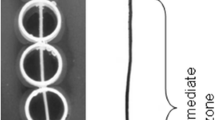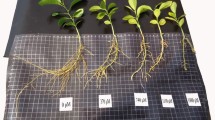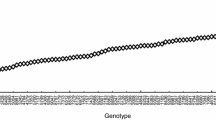Abstract
In this study, the role of root organic acid synthesis and exudation in the mechanism of aluminum tolerance was examined in Al-tolerant (South American 3) and Al-sensitive (Tuxpeño and South American 5) maize genotypes. In a growth solution containing 6 μM Al3+, Tuxpeño and South American 5 were found to be two- and threefold more sensitive to Al than South American 3. Root organic acid content and organic acid exudation from the entire root system into the bulk solution were investigated via high-performance liquid chromatographic analysis while exudates collected separately from the root apex or a mature root region (using a dividedroot-chamber technique) were analyzed with a more-sensitive ion chromatography system. In both the Al-tolerant and Al-sensitive lines, Al treatment significantly increased the total root content of organic acids, which was likely the result of Al stress and not the cause of the observed differential Al tolerance. In the absence of Al, small amounts of citrate were exuded into the solution bathing the roots. Aluminum exposure triggered a stimulation of citrate release in the Al-tolerant but not in the Al-sensitive genotypes; this response was localized to the root apex of the Al-tolerant genotype. Additionally, Al exposure triggered the release of phosphate from the root apex of the Al-tolerant genotype. The same solution Al3+ activity that elicited the maximum difference in Al sensitivity between Al-tolerant and Al-sensitive genotypes also triggered maximal citrate release from the root apex of the Al-tolerant line. The significance of citrate as a potential detoxifier for aluminum is discussed. It is concluded that organic acid release by the root apex could be an important aspect of Al tolerance in maize.
Similar content being viewed by others
Abbreviations
- SA3:
-
South American 3, an Al-tolerant maize cultivar
- SA5:
-
South American 5, an Al-sensitive maize cultivar
References
Delhaize, E., Craig, S.V., Beaton, C.D., Bennet, R.J., Jagadish, V.C., Randall, P.J. (1993a) Aluminum tolerance in wheat (Triticum aestivum L) I. Uptake and distribution of aluminum in root apices. Plant Physiol.103, 685–693
Delhaize, E., Ryan, P.R., Randall, P.J. (1993b) Aluminum tolerance in wheat (Triticum aestivum L.). II. Aluminum-stimulated excretion of malic acid from root apices. Plant Physiol.103, 695–702
Dinkelaker, B., Römheld, V., Marschner, H. (1989) Citric acid excretion and precipitation of calcium citrate in the rhizosphere of white lupin (Lupinus albus). Plant Cell Environ.12, 285–292
Foy, C.D. (1988) Plant adaptation to acid, aluminum-toxic soils. Commun. Soil Sci. Plant Anal.19, 959–987
Foy, C.D., Lee, H.H, Coradetti,C.A., Taylor, G.J. (1990) Organic acids related to differential aluminum tolerance in wheat (Triticum aestivum). In: Plant nutrition — physiology and application, pp. 381–389, M.L. van Beusischem ed. Kluwer Academic Publishers
Granados, G., Pandey, S., Ceballos, H. (1993) Response to selection for tolerance to acid soils in a tropical maize population. Crop Sci.33, 936–940
Hoffland, E., Findenegg, G.R., Nelemans, J.A. (1989) Solubilization of rock phosphate by rape. II. Local root exudation of organic acids as a response to P-starvation. Plant Soil113, 161–165
Huang, J.W., Grunes, D.L., Kochian, L.V. (1993) Aluminum effects on calcium (45Ca2+) translocation in aluminum-tolerant and aluminum-sensitive wheat (Triticum aestivum L.) cultivars. Plant Physiol.102, 85–93
Hue, N.V., Craddock, G.R., Adams, F. (1986) Effect of organic acids on aluminum toxicity in subsoils. Soil Sci. Soc. Am. J.50, 28–34
Kasim, F., Wassom, C.E. (1990) Genotypic response of corn to aluminum stress. I. Seedling tests for measuring aluminum tolerance in nutrient solutions. Indonesian J. Crop Sci.5, 41–51
Kasim, F., Haag, W.L., Wassom, C.E. (1990) Genotypic response of corn to aluminum stress. II. Field performance of corn varieties in acid soils and its relationship with performance at seedling stage. Indonesian J. Crop Sci.5, 53–65
Kinraide, T.B. (1988) Proton extrusion by wheat root exhibiting severe aluminum toxicity symptoms. Plant Physiol.88, 418–423
Kinraide, T.B. (1991) Identity of the rhizotoxic aluminum species. Plant Soil134, 167–178
Kinraide, T.B., Parker, D.R. (1987) Cation amelioration of aluminum toxicity in wheat. Plant Physiol.83, 546–551
Kinraide, T.B., Parker, D.R. (1989) Assessing the phytotoxicity of mononuclear hydroxy-aluminum. Plant Cell Environ.12, 479–487
Kochian, L.V. (1995) Cellular mechanisms of aluminum toxicity and resistance in plants. Annu. Rev. Plant Physiol. Plant Mol. Biol.46, 237–260
Lüttge, U., Clarkson, D.T. (1992) Mineral Nutrition: aluminum. In: Progress in botany, vol. 53, pp. 63–77. Springer Verlag, Berlin Heidelberg
Miyasaka, S.C., Buta, J.G., Howell, R.K., Foy, C.D. (1991) Mechanisms of aluminum tolerance in snapbeans. Plant Physiol.96, 737–743
Morré, D.J., Jones, D.D., Mollenhauer, H.H. (1967) Golgi apparatus mediated polysacharide secretion by outer root cap cells ofZea mays. I. Kinetics and secretory pathways. Planta74, 286–301
Ownby, J.D., Popham, H.R. (1989) Citrate reverses the inhibition of wheat root growth caused by aluminum. J. Plant Physiol.135, 588–591
Pandey, S., Gardner, C.O. (1992) Recurrent selection for population, variety and hybrid improvement in tropical maize. Adv. Agron.48, 1–87
Parker, D.R., Norvell, W.A., Chaney, R.L. (1995) GEOCHEM-PC: a chemical speciation program for IBM and compatible personal computers. In: Soil chemical equilibrium and reaction models, Loeppert, R.H. ed. ASA and SSSA, Madison, Wis. SSSA Spec. Publ.42, 253–270
Ryan, P.R., Di Tomaso, J.M., Kochian, L.V. (1993) Aluminum toxicity in roots: an investigation of spatial sensitivity and the role of the root cap. J. Exp. Bot.44, 437–446
Suhayda, C.G., Haug, A. (1986) Organic acids reduce aluminum toxicity in maize root membranes. Physiol. Plant.68, 189–195
Taylor, G.J. (1988) The physiology of aluminum tolerance in higher plants. Commun. in Soil Sci. Plant Anal.19, 1179–1194
Taylor, G.J. (1991) Current views of the aluminum stress response; the physiological basis of tolerance. Curr. Top. Plant Biochem. Physiol.10, 57–93
Author information
Authors and Affiliations
Corresponding author
Additional information
The authors would like to express their appreciation to Drs. John Thompson, Ross Welch and Mr. Stephen Schaefer for their training and guidance in the use of the chromatography systems. This work was supported by a Swiss National Science Foundation Fellowship to Didier Pellet, and U.S. Department of Agriculture/National Research Initiative Competitive Grant 93-37100-8874 to Leon Kochian. We would also like to thank Drs. S. Pandey and E. Ceballos from the CIMMYT Regional office at CIAT Cali, Colombia for providing seed for the maize varieties and inbred line.
Rights and permissions
About this article
Cite this article
Pellet, D.M., Grunes, D.L. & Kochian, L.V. Organic acid exudation as an aluminum-tolerance mechanism in maize (Zea mays L.). Planta 196, 788–795 (1995). https://doi.org/10.1007/BF01106775
Received:
Accepted:
Issue Date:
DOI: https://doi.org/10.1007/BF01106775




